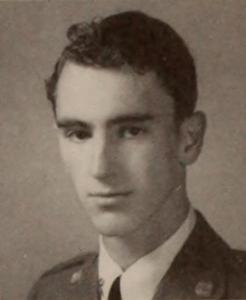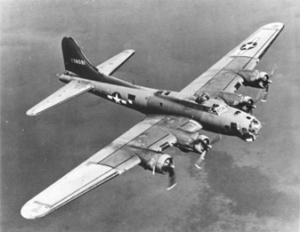Scroll of Honor – Dixon Franklin Pearce, Jr.
Targeting Oil
Written by: Kelly Durham
When Clemson’s cadets left campus at the end of the spring semester in May 1943, returning in the fall was not an option for most. The War Department had directed that college-age men report for active duty. College campuses across the country were converted into classrooms for advanced technical training to meet the needs of the armed forces. Dixon Franklin Pearce, Jr., a junior chemistry major from Greenville, entered the Army that same month. Pearce volunteered for the Army Air Force, completed his basic training, and then attended navigator school. He emerged in April 1944 as a second lieutenant and in July was sent to England, where he joined the heavy bombers of the Eighth Air Force.
By the time of Pearce’s arrival in England, the Eighth Air Force was at the peak of its wartime strength with more than 200,000 personnel, forty heavy bomber groups, fifteen fighter groups, and four specialized support groups. Second Lieutenant Pearce was assigned to the 94th Bomb Group, operating from Bury St. Edmunds in Suffolk, less than fifty miles from the English Channel.
The Eighth Air Force had suspended its strategic bombing campaign to target transportation networks, railroads, and bridges in support of the D-Day invasion of Normandy in early June. By the time of Pearce’s arrival, the Eighth had switched back to targeting the German oil industry. Having achieved air superiority, the Eighth’s heavy bombers pounded petroleum related targets throughout Germany and as far to the east as Hungary. The intent of the campaign was to cripple Germany’s war making capabilities by drying up its fuel tank.
 By November, Pearce had been awarded the Air Medal with two oak leaf clusters suggesting that he had completed at least fifteen combat missions. On November 3, he was promoted to first lieutenant.
By November, Pearce had been awarded the Air Medal with two oak leaf clusters suggesting that he had completed at least fifteen combat missions. On November 3, he was promoted to first lieutenant.
The following day, Pearce and his crew, led by pilot Harry Hummel, were ordered on Mission 700 to bomb enemy oil installations in western Germany. Flying aboard a B-17G nicknamed St. Christopher’s Kids, Pearce and crew set out with more than eleven hundred heavy bombers on the long flight to Hamburg, Germany. More than a thousand of the bombers that started out on the mission reached their targets, dropping nearly three thousand tons of bombs.
St. Christopher’s Kids was hit by German anti-aircraft fire, damaging two of the airplane’s engines and making it impossible for the aircraft to keep up with its formation. After clearing the North Sea coast, the aircraft reported that it was attempting to turn back for a landing in Holland, then still occupied by the Germans. Shortly after that transmission, the aircraft radioed that it would instead ditch in the sea. The stricken airplane, continuing to lose altitude, radioed Air Sea Rescue. At 1342 hours, St. Christopher’s Kids last reported its position as north of Terschelling, one of the West Frisian Islands off the north coast of the Netherlands.
No rescue was affected. The nine crewmembers of St. Christopher’s Kids were among forty-six Eighth Air Force personnel listed as missing in action on Mission 700. Pearce’s crew was never recovered.
Pearce was awarded the Purple Heart and a third oak leaf cluster to his Air Medal, indicating that he had flown twenty of the thirty-five combat missions required to complete a tour of duty. He was survived by his parents and two brothers, one of whom was serving in the Navy. First Lieutenant Pearce is memorialized at the Netherlands American Cemetery, Margraten, Netherlands and at the Springwood Cemetery in Greenville.
required to complete a tour of duty. He was survived by his parents and two brothers, one of whom was serving in the Navy. First Lieutenant Pearce is memorialized at the Netherlands American Cemetery, Margraten, Netherlands and at the Springwood Cemetery in Greenville.
For more information on First Lieutenant Dixon Franklin Pearce, Jr. see:
https://soh.alumni.clemson.edu/scroll/dixon-franklin-pearce-jr/
For additional information on Clemson University’s Scroll of Honor visit:
https://soh.alumni.clemson.edu/
